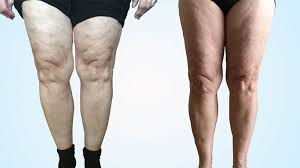Cellulite, a common concern for many individuals, is a skin condition characterized by a dimpled or lumpy appearance, often compared to the texture of orange peel. It most commonly appears on the buttocks and thighs, including the legs. Despite being a completely natural and harmless condition, many people seek ways to reduce its appearance for aesthetic reasons. If you’re searching for “how to get rid of cellulite in legs,” this comprehensive guide explores ten proven strategies for combating cellulite effectively.
Understanding Cellulite
Before delving into the strategy to combat cellulite, it’s essential to understand what it is and why it appears. Cellulite occurs when fat deposits push through the connective tissue beneath the skin. It’s more common in women than men due to the different distributions of fat, muscle, and connective tissue.
What Causes Cellulite?
Although the exact cause of cellulite is unknown, it results from an interaction between the connective tissue in the dermatological layer below the skin surface and the layer of fat just below it. Factors like aging, hormones, genetics, and lifestyle can influence the amount and visibility of cellulite.
Strategy 1: Regular Exercise
One of the most effective ways to combat cellulite in the legs. Regular physical activity, especially strength training and cardio exercises, can tone the muscles and reduce the appearance of cellulite.
How Does Exercise Help?
Exercise helps to burn fat and tone the muscles in your legs, making your skin look smoother. Also, improved blood circulation induced by regular workouts can help to keep your skin healthy and cellulite-free.
Strategy 2: Healthy Diet
Diet plays a crucial role in the appearance of cellulite. Consuming a balanced diet rich in fruits, vegetables, lean proteins, and healthy fats can help manage weight and maintain smooth skin.
Which Foods to Include and Avoid?
Include foods high in fiber and whole grains, which can help remove waste and toxins from the body, potentially reducing cellulite.
On the other hand, limit your intake of processed foods, salt, and sugar, as they can make cellulite more visible.
Strategy 3: Hydration
Staying hydrated is vital for overall health and can help reduce cellulite’s appearance.
How Does Hydration Help?
Water keeps the skin hydrated and rejuvenated, which can reduce the visibility of cellulite. It also aids in toxin removal, potentially minimizing cellulite formation.
Strategy 4: Dry Brushing
Dry brushing is a naturd that is often suggested to help with cellulite. It involves brushing the skin with a hard-bristled brush to boost circul and skin health.
Dry Brushing Technique
Dry brushing should be done before taking a shower,upwardard motion towards the heart. This helps stimulate blood and lymph flow, potentially reducing the appearance of cellulite.
Strategy 5: Topical Treatments
Topical treatments, like creams and lotions containing ingredients such as caffeine, retinol, and antioxidants, may help improve the appearance of cellulite.
How Do Topical Treatments Work?
These creams work by tightening the skin, promoting circulation, and breaking down fat cells in the body, potentially making cellulite less noticeable.
Strategy 6: Massage
Regular massages can help reduce cellulite by improving lymphatic drainage, reducing tension in the skin and connective tissues, and boosting circulation.
Massage Techniques for Cellulite
Techniques such as kneading and rolling the skin can be effective. There are also specific anti-cellulite massages, like endermologie, that you can try.
Strategy 7: Laser and Radiofrequency Treatments
Laser and radiofrequency treatments are non-invasive methods that have shown promise in reducing cellulite. These treatments work by sending heat into the skin, breaking down underlying fat cells and stimulating collagen production.
Types of Treatments
Some common treatments include radiofrequency (RF) therapy, laser treatment, and acoustic wave therapy. It’s essential to consult with a skincare specialist or dermatologist to determine the most suitable treatment for you.
Strategy 8: Collagen Supplements
Collagen, a protein that helps maintain skin elasticity, can be beneficial in the fight against cellulite.
How Does Collagen Help?
As we age, collagen production decreases, leading to loose, saggy skin that can enhance cellulite’s appearance. Consuming collagen supplements may help restore skin elasticity and reduce the appearance of cellulite.
Strategy 9: Weight Loss
If you’re overweight or obese, losing weight might help reduce cellulite. However, it’s essential to remember that cellulite can affect people of all sizes, and weight loss may not eliminate cellulite.
Healthy Weight Loss
Adopting a healthy diet and regular exercise routine can help you lose weight gradually and safely. Rapid weight loss can lead to saggy skin, which could make cellulite appear more pronounced.
Strategy 10: Professional Treatments
For those who wish to explore more intensive treatments, professional options are available, like Cellfina and Cellulase, which can significantly reduce cellulite.
What are Professional Treatments?
Cellfina is a minimally invasive procedure that cuts cellulite-causing bands beneath the skin, while Cellulaze uses lasers to break down the rugged bands under the skin that cause cellulite. These treatments can provide longer-lasting results but should be considered only after consulting with a certified professional.
Conclusion
While cellulite is a natural and common occurrence, it’s understandable that many people seek to reduce its appearance. Whether through lifestyle changes, natural remedies, or professional treatments, several effective strategies for combating cellulite in the legs exist. Remember, everyone’s body responds differently to these methods, and what works for one person may not exist to work for another. It may take some trial and error to find what works best for you, but with patience and consistency, it’s possible to improve the appearance of cellulite.

